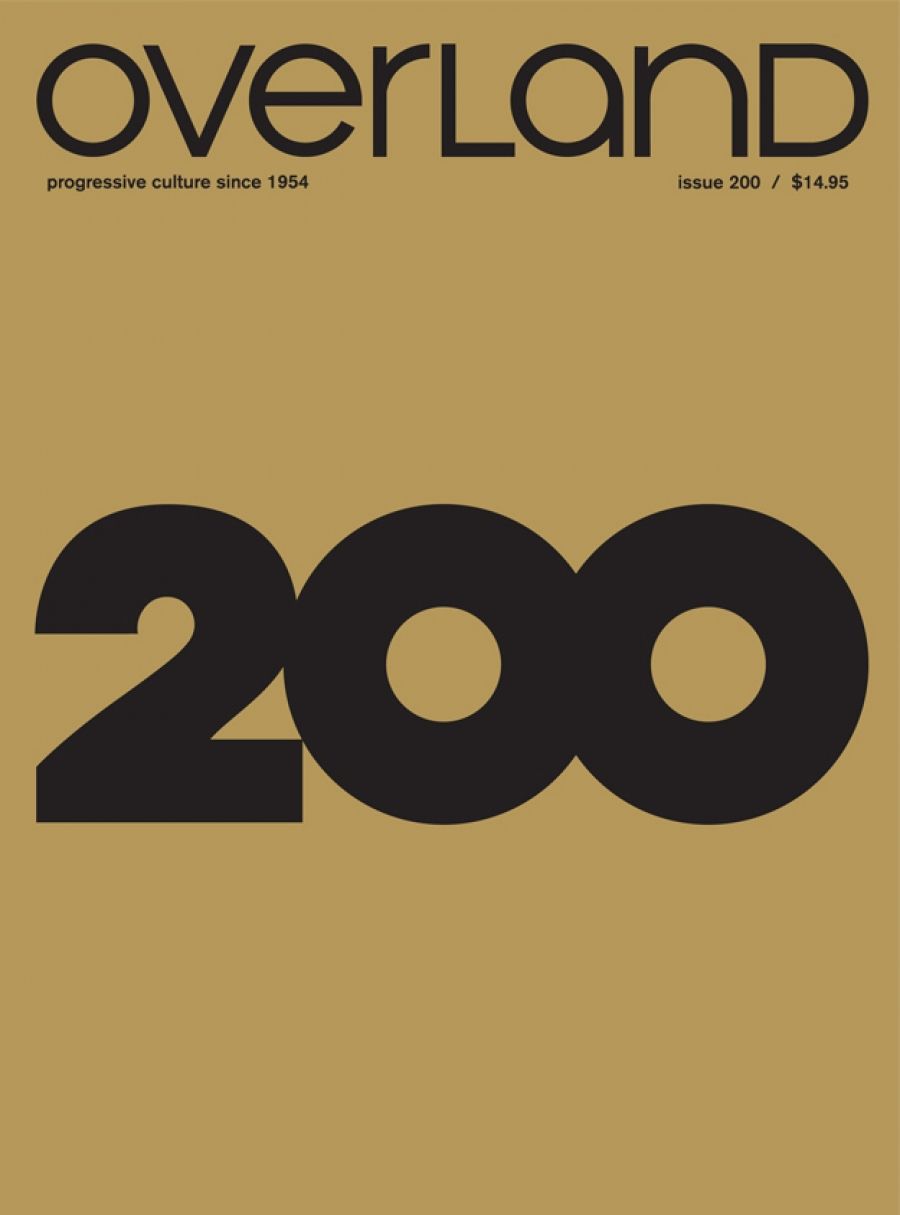
- Free Article: No
- Contents Category: Journals
- Review Article: Yes
- Online Only: No
- Custom Highlight Text:
From Menzies to Gillard, from the Cold War to Pacific solutions, the history of Overland magazine offers a leftist version of post-World War II Australian political, cultural and literary life. This issue of Overland is its two hundredth. As Jeff Sparrow, the current Editor, points out, survival is an achievement: ‘The “little magazine” is a peculiar animal. The life cycle of the species generally follows a predictable pattern: birth (usually marked by the ritual issuing of manifestos) and rapid growth, followed by financial crisis, paralysis and death, a cycle that typically unfolds within the span of six months or so.’ Sparrow, one of Australia’s more penetrating commentators, might have granted himself more space to discuss the future of Overland, and, more broadly, to reflect on challenges facing activists who challenge the assumption that capitalism can save – is saving – the world.
- Book 1 Title: Overland 200
- Book 1 Biblio: Overland, $14.95 pb, 120 pp
Overland 200’s strength lies in its diversity of essays and contributors. These include Clive Hamilton, who condemns the ABC’s efforts to avoid bias in its climate change coverage. Although Hamilton is convincing enough, he tends to assume that readers will agree with him, and misses an opportunity to reflect more broadly on the mainstream media’s debilitating addiction to ‘balance’. There’s also Jacinda Woodhead’s observation of a hip hop workshop in Footscray. Although Woodhead says that she is not a journalist, her sharp reportage provides poignant reflections on racism and on young people expressing themselves. There is also Rjurik Davidson’s essay on the proliferation of Creative Writing courses in Australia, in which he interviews students, academics, editors, and publishers. Is the country benefiting from hordes of tertiary-trained fiction writers wandering about ‘showing not telling’? Davidson sits on the fence, which is probably a good place to be. He affords his interviewees anonymity, which is odd given the subject matter (we’re not talking defence contracts) and the fact that none of his sources says anything especially candid.
Polemical writing sets out to provoke, to incite, to attack complacency, but it is easy for fist-waving to become the main agenda. Chris Graham’s aggressive denunciation of Noel Pearson doesn’t do justice to the complexities of Pearson’s politics, actions, strategies, public utterances, or writings. Nor does it delve sufficiently into the reasons why many Australians rush to embrace Pearson and, sometimes, to endorse him for their own purposes. Most especially, Graham doesn’t do justice to his own objections to Pearson.
In Graham’s defence, there is a fine line between polemic and rant: contrast his essay with Ben Eltham’s forceful call for the Australia Council’s abolition. Eltham overstates his case and offers messy-sounding alternatives. Somehow, though, he gets the tone about right, demonstrating that we do need to debate the future of arts funding.
The pick of the essays is Anwyn Crawford’s ‘Permanent Daylight’, a compelling discussion of feminism and capitalism through the prism of women’s body image: ‘Anorexia is not “caused” by images of underweight actresses and models, nor will it be eradicated by the inclusion of more “realistic” female bodies in magazines and cinema. To argue on this terrain is still to accede to the logic of capital: that a woman must be an image in order to exist. The great challenge of contemporary feminism is not to demand appearance for capitalism’s sake, but to overturn capital’s dynamic of appearance: we must create the conditions for women’s invisibility from the realm of images in order to become visible as historical subjects.’ Crawford’s commingling of theory and real life – including her own life – results in writing that is dense in the best of ways. It doesn’t mean that she’s right, but her ideas compel thoughtful and contextual responses.
While there is often not enough short fiction in ‘little magazines’, here the inclusion of only three stories, all terrific, seems apt. Christos Tsiolkas’s mock essay ‘Rococo’ is about a minor eighteenth-century Portuguese artist and the contemporary sale of one of his paintings. Karen Hitchcock’s ‘Forging Friendship’ occasionally drifts, but is a sharply funny take on a young woman’s lost friendship. Although it is rather cramped for space, Janet Turner Hospital’s ‘Weird People’ is a sad and quite lovely tale about a bloke called Rufus who only talks to whales.
Perhaps the most intriguing piece in Overland 200 is Bruce Mutard’s graphic re-imagining of John Morrison’s short story, ‘Nine O’clock Finish’, published in the first issue of Overland, in 1954. Morrison was a waterside worker and communist, and ‘Nine O’clock Finish’ chronicles the beginnings of an industrial dispute on the wharfs. Sparrow argues that whatever the failings of social realist writers, ‘authors like Morrison forced literature out of its comfort zone, something that urgently needs to happen today’. Mutard’s graphic retelling is wonderful: I found myself wanting to climb into the frames. Morrison’s original dialogue is glaringly didactic.
Throughout Overland 200, a number of commentators offer snapshot perspectives on challenges facing the contemporary left. These are of mixed interest. For example, while John Pilger’s and Carmen Lawrence’s offerings are rather hollow, Dennis Altman and Sophie Cunningham both interrogate what being ‘left’ actually means in 2010. And Jill Sparrow writes, ‘One of our biggest problems is that most people, even those sympathetic to the Left, don’t have confidence that left-wing ideas or the actions we promote (such as demonstrations and strikes) can actually change anything.’ I would go further and suggest that many people use strikes and demonstrations to fit a little dissent into their busy schedules. If this is so, Overland offers a feisty rejoinder to such complacency.


Comments powered by CComment